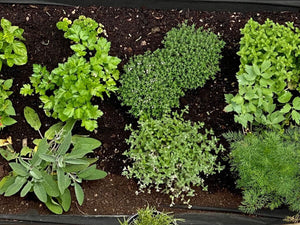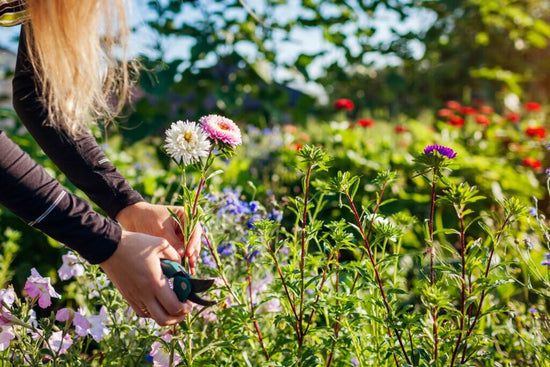How to Plant and Grow Dianthus Flowers from Seed
DianthusDianthus is an old cottage garden favorite. Perennial dianthus flowers have been cultivated since the 16th century, and there are now hundreds of varieties. Our favorite heirloom dianthus is easy to grow from seed and low-maintenance year after year.

Dianthus is one of the earliest flowers I remember nurturing. They were a reliable bloomer each spring in our backyard rock garden. The serrated edges of the dianthus petals looked like they’d been trimmed by pinking shears. Even at a young age, I wondered how I could increase their flowers and make the plants spread. With the tips in this dianthus growing guide, you can make the most of these low-maintenance flowers.
Dianthus Chinensis
Baby Doll is an annual dianthus that grows low to the ground with a spreading habit.
This heirloom variety of Dianthus chinensis produces a profusion of flowers.
The deep crimson, rose, pink, and white blooms have intricately serrated petals and have a jasmine-like scent.
How to Grow Dianthus from Seed
Dianthus flowers can be perennial, annual, and biennial, but they all have similar growing requirements. Dianthus seeds can be sown outdoors or started indoors. Start seeds six weeks before transplanting outdoors to ensure you have blooms the first year in zones with a shorter growing season.
Sowing Dianthus Seeds Outdoors
When sowing dianthus outdoors, you can plant in early spring or late summer, depending on your gardening zone. Dianthus prefer cool temperatures and will go dormant in hot summers.

Sowing Dianthus Seeds Indoors
Starting seeds indoors will allow you to control the growing conditions and have healthier plants to place outside when conditions are favorable. Once the seeds have sprouted, place a grow light close to the seedlings. This will ensure they have enough light and prevent them from becoming leggy.
Eventually, you will need to transplant your dianthus seedlings outdoors. Before transplanting, harden off the seedlings. This will get them acclimated to outdoor conditions and help prevent transplant shock.
Plant seedlings to the depth they were already growing. Space plants 6 inches apart. Transplanting in the evening and watering thoroughly can help lessen transplant shock. Seedlings can be placed outside when temperatures are above 40ºF. If a light frost is expected, cover plants with a protective frost blanket.

Tips for fail-proof dianthus seed germination
Press seeds into moist seed starting mix and cover lightly with soil.
Keep the seeds moist until they germinate, in 14 to 28 days.

How to Care for Dianthus Plants
Once established, dianthus is easy to care for. With full sun, well-draining soil, and regular deadheading, you can enjoy these beautiful heirloom flowers to their fullest.
Sun
For the best blooms, dianthus need at least 6 hours of daily sunlight, which means full sun to partial shade. In cooler climates, more sunlight is better, and in hot climates, afternoon shade can be beneficial.
Soil
Dianthus has adapted to many soil conditions, but it doesn’t do well in wet soil. The roots will rot in heavy clay soil that holds too much water. The optimal soil for dianthus is very well-draining, slightly sandy, and with a more alkaline pH.
Weeding
Keep weeds from competing with the dianthus roots. Mulching isn’t recommended because it can lead to stem rot. If you use mulch to control weeds, keep it away from the stems.
Water
Dianthus doesn’t need a lot of water. However, if you live in a hot, dry climate, the plants will need more water than in cooler, humid areas. Dianthus are more susceptible to problems from too much water than from being a little on the dry side.
Deadheading and pruning
Once the dianthus blooms are spent, they start producing seeds. By regularly deadheading, you can encourage the plant to continue producing flowers. When the flowering season is over, you can cut back perennial dianthus plants. Always leave at least ⅓ of the plant for healthy growth into the following year.

Solutions for Common Pests and Diseases
No gardener likes to see their flowers destroyed by pests and diseases, but dianthus is usually spared from these problems.
Using effective watering to keep the plants dry can avoid problems with rotting roots and leaves.
Common pests like aphids, slugs, and snails can be neutralized with natural methods.
Deer usually don’t eat dianthus, but rabbits may munch on plants.

Harvesting Dianthus Flowers
Dianthus make an excellent cut flower with a long vase life. Cut dianthus can stay fresh from 7 to 21 days. This amazing vase life, along with their small size and range of colors, makes them a top choice as a filler flower. Dianthus flowers can be harvested throughout the blooming season.
To get the most out of your cut dianthus, harvest flowers early in the morning while it is still cool and after the dew has dried. Place stems in a bucket of cool water and bring them indoors, away from heat and direct sunlight.

Dianthus FAQs
Where is the best place to plant dianthus?
The best location for growing dianthus is a spot with well-draining soil in full sun.
Does Dianthus come back every year?
There are many kinds of dianthus, but perennial varieties will come back. However, even the perennial varieties will eventually need to be reseeded.
Growing Dianthus in Pots
Dianthus can be successfully grown in containers. Again, use sandy soil and deadhead often.
Dianthus are beautiful flowers to grow. They have an extremely long vase life, which makes them popular in flower farms. Dianthus seeds can be started indoors or sown outside. If you want your dianthus plants to self-seed, leave some of the flowers at the end of the season. Once established, you can enjoy dianthus for several years. Keep picking the flowers so that they will keep growing.
Plant dianthus from seed in your cutting or cottage garden. You’ll enjoy this heirloom favorite both indoors and out.
4 comments
Popular Posts
-

How to Grow Long-Lasting, Fragrant, Heirloom Carnations
-

Our Favorite Herbs to Plant in Fall for a Flavorful Harvest






Hi Cory, Dianthus are pretty good at self-seeding. You can let them go to seed or plant seeds in fall or late winter. They will germinate when the ground warms up in the spring. Just be aware that young seedlings can be damaged by frost.
Could I sow seeds in winter for them to naturally germinate when temperatures warm in spring? I would be planting these in the south where we don’t get many hard freezes.
Thanks for the question, Leslie. Dianthus seeds are small and black.
what am l looking for in seed when l snip the spent flowers. are they smell black or are they bigger natural color lm looking for. this is my first experience with these great smelling beauties
Leave a comment